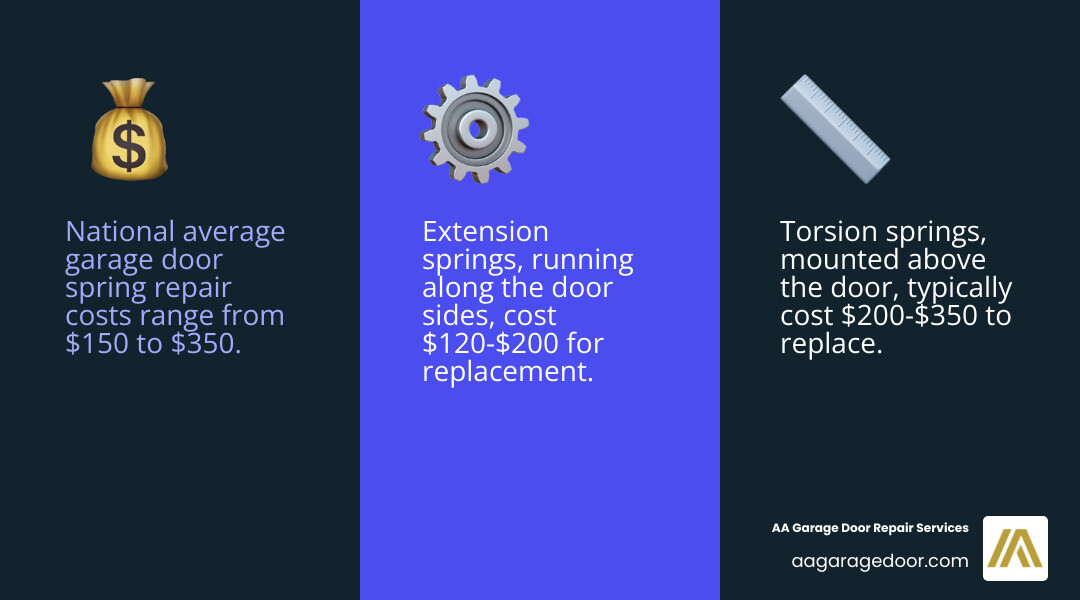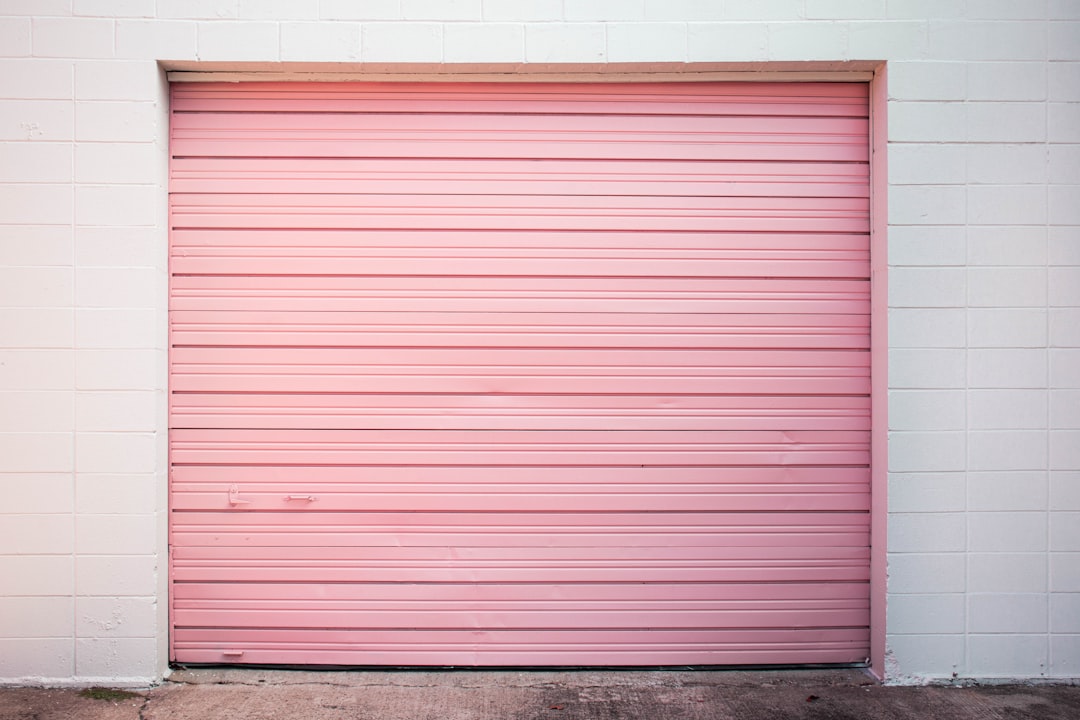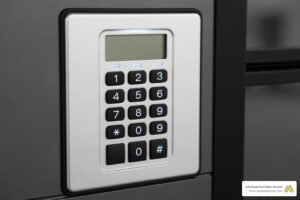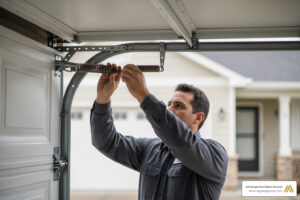Why Your Garage Door Spring is So Important
When you hear that loud bang from your garage and suddenly can’t open the door, you’re likely facing a garage door spring repair price that ranges from $150 to $350 on average. Here’s what you need to know about costs:
Quick Cost Breakdown:
- Average total cost: $150-$350
- Torsion spring replacement: $200-$350
- Extension spring replacement: $120-$200
- Parts only: $30-$100 per spring
- Labor: $75-$150
Your garage door springs are the unsung heroes of your home’s most used entrance. These tightly wound coils counterbalance the weight of your garage door – which can weigh 300+ pounds – making it possible for you or your opener to lift it with ease.
When springs break, your door becomes a safety hazard and your opener can suffer expensive damage from overwork. For reliable and safe garage door repair services, it’s crucial to understand what drives repair costs and why professional service matters.
I’m David Sands, owner of AA Garage Door LLC with over 23 years of experience helping Twin Cities homeowners steer garage door spring repair price decisions. Through thousands of spring replacements, I’ve learned that understanding costs upfront helps families make smart, safe choices for their homes.

Understanding the Average Garage Door Spring Repair Price
When your garage door spring snaps at 7 AM and you’re running late for work, the first question that pops into your head is probably “How much is this going to cost me?” The good news is that garage door spring repair price is fairly predictable across the country.
Most homeowners pay between $150 and $350 for professional spring replacement, with the national average landing around $250. This covers both the new spring parts and the skilled labor needed to install them safely.
What makes up your total cost? The parts themselves are surprisingly affordable – usually $20 to $100 per spring depending on the type and quality. The majority of your bill goes toward professional labor, which typically runs $75 to $150. This might seem steep, but spring replacement involves working with components under extreme tension that can cause serious injury if handled incorrectly.
The type of spring your door uses makes a big difference in your final bill. Torsion springs – those thick, horizontal coils mounted above your garage door opening – are the workhorses of the garage door world. They’re more durable and safer, but they’ll cost you about 50% more to replace than extension springs.
Extension springs run along the tracks on either side of your door and are less expensive to replace, but they don’t last as long and pose more safety risks when they fail.
| Spring Type | Average Total Cost (Installed) | Average Parts Cost (per spring) | Average Labor Time |
|---|---|---|---|
| Torsion Spring | $200 – $350 | $30 – $100 | 1-2 hours |
| Extension Spring | $120 – $200 | $20 – $50 | 1-1.5 hours |
Here’s something that surprises many homeowners: we always recommend replacing both springs at the same time, even if only one has broken. Think of it like replacing tires – if one fails, the other isn’t far behind since they’ve both been working under the same conditions for the same amount of time.
Replacing both springs ensures your door operates smoothly and prevents that frustrating scenario where you pay for another service call just a few months later when the second spring gives out. Plus, many contractors offer a slight discount on labor when replacing multiple springs during the same visit.
If you have two garage doors that both need spring work, you might pay anywhere from $275 to $425 total, depending on the spring types and any additional repairs needed.
For more detailed information about our spring replacement process and why professional installation matters, check out our Garage Door Spring Repair services.
Key Factors That Influence Your Final Repair Bill
Several key factors can make your garage door spring repair price swing from the lower end of the range to the higher end. At AA Garage Door Repair Services, we believe in complete transparency – no surprise fees or hidden costs. When we give you a quote, it’s itemized so you know exactly what you’re paying for and why.
Understanding these cost variables helps you make informed decisions about your repair and budget accordingly. Let’s break down what really impacts your final bill.
Spring Type: Torsion vs. Extension Springs
The type of spring system your garage door uses is probably the biggest factor affecting your repair cost. Think of it like the difference between a Honda Civic and a pickup truck – they both get you where you need to go, but one costs more to maintain.
Torsion springs sit on a metal shaft directly above your garage door opening. They twist and untwist to lift your door, kind of like winding up a giant rubber band. These springs are the workhorses of the garage door world – they last longer (typically 8-15 years), operate more smoothly, and are safer because they’re contained on a shaft. If one breaks, it won’t go flying across your garage. The downside? They’re more complex to install and typically cost between $200 to $350 to replace.
Extension springs stretch along the sides of your door tracks, extending and contracting like giant rubber bands. They’re simpler in design and less expensive to replace, usually running $120 to $200. However, they don’t last as long (7-12 years) and can be more dangerous when they snap – without proper safety cables, they can become dangerous projectiles.
Some homeowners choose to convert their spring system. Converting from extension to torsion springs costs more upfront ($400 to $800) but offers better safety and longevity. Converting the other direction (torsion to extension) runs $250 to $500 and is less common.
Garage Door Size, Weight, and Type
Your garage door’s physical characteristics directly impact what kind of springs it needs – and stronger springs cost more money.
Size matters when it comes to springs. A standard single garage door needs different springs than a double-wide door. Double-door springs are beefier and typically add $15 to $30 per spring to your cost.
Door materials make a huge difference in weight. That beautiful wooden door might look great, but it can weigh significantly more than a basic steel door. Insulated doors also weigh more than their uninsulated counterparts. Heavier doors need stronger, higher-gauge springs, which cost more to manufacture and purchase.
The type of door you have also affects spring choice. Sectional doors (the most common type) typically use torsion springs with replacement costs of $75 to $150 per spring. Tilt-up doors often use extension springs ($50 to $100 per spring), while roll-up doors usually require torsion springs similar in cost to sectional doors.
Labor Costs and Regional Price Variations
Labor typically accounts for $75 to $150 of your total garage door spring repair price, but several factors can influence this cost.
Service call fees cover our technician’s travel time and initial assessment. We include this in our transparent pricing so you know what to expect upfront. Job complexity can affect labor time – if your springs are in a tight spot or you have an unusual setup, it might take longer to complete the work safely.
Regional differences do exist. Garage door repair costs in the busy Twin Cities metropolitan area might vary slightly from prices in rural Western Wisconsin, though we strive to keep our pricing fair and competitive across all our service areas, including St. Paul, Minneapolis, Hudson WI, and Apple Valley.
Emergency situations requiring emergency garage door repair outside normal business hours typically incur additional fees of $50 to $100 or a 15-25% markup. We understand emergencies don’t wait for convenient times, which is why we offer 24/7 service.
Additional Repairs and Parts
Sometimes a broken spring is just the tip of the iceberg. When springs fail, they can cause a domino effect of problems that need addressing.
Replacing both springs is always our recommendation, even if only one is broken. This ensures balanced operation and prevents you from facing another repair call in a few weeks when the second spring inevitably fails.
If you have multiple garage doors, having springs replaced on all of them during one visit can save on trip fees. Two doors typically cost $275 to $425 total, while three doors might run $350 to $700.
Worn cables often need replacement alongside springs. When a spring breaks, the remaining cable takes all the door’s weight, causing rapid wear or immediate failure. Cable replacement adds $80 to $185 to your bill, but addressing it now prevents future problems. You can learn more about garage door cable repair on our services page.
Damaged rollers and bent tracks can result from a malfunctioning spring system. When your door operates unevenly due to a broken spring, it puts stress on these components. Fixing everything at once is usually more cost-effective than scheduling separate repair visits.
DIY vs. Hiring a Professional: A Cost and Safety Analysis
When your garage door spring snaps and you’re staring at a garage door spring repair price of $150 to $350, I understand the temptation to tackle this yourself. After all, how hard could it be to swap out a spring, right?
Well, let me share something from my 23 years in this business: garage door spring replacement is one of the most dangerous DIY projects a homeowner can attempt. The potential savings of $75 to $150 in labor costs simply don’t justify the serious risks involved.
The Hidden Costs and Dangers of DIY Spring Replacement
Here’s what most homeowners don’t realize: garage door springs store enough energy to lift a 300-pound door thousands of times. That extreme tension makes them incredibly dangerous when they release unexpectedly. I’ve seen too many DIY attempts end in serious injury – broken bones, deep cuts, and worse.
When a torsion spring snaps during amateur installation, it becomes a dangerous projectile that can fly across your garage with enough force to dent metal or shatter glass. Extension springs pose similar risks, especially without proper safety cables in place.
The specialized tools required for safe spring installation aren’t something you’ll find at your local hardware store. Professional winding bars, spring clamps, and tension gauges are expensive and require training to use safely. Trying to improvise with regular tools is asking for trouble.
Even if you avoid injury, improper installation can create a cascade of expensive problems. Install the wrong spring size or set incorrect tension, and you’ll put excessive strain on your garage door opener, cables, and tracks. What started as a $250 spring repair can quickly become a $800+ system replacement.
Many homeowners don’t realize that DIY repairs often void warranties on both the garage door and opener. Manufacturers require certified professional installation to maintain coverage. That money you saved on labor could cost you thousands if major components fail later.
For insight into why certain repairs should always be left to professionals, check out our guide on 3 Garage Door Repairs Best Left for the Professionals.
The Value of Professional Garage Door Spring Repair
When you hire a professional for spring replacement, you’re not just paying for labor – you’re investing in safety first. Our technicians have the training and experience to handle high-tension springs safely, protecting both you and your property from harm.
Technician expertise means we can quickly identify the exact spring type and size your door needs. We’ve replaced thousands of springs over the years, so we know how to spot potential issues before they become bigger problems. This experience translates to efficiency – most spring replacements take us under two hours from start to finish.
We arrive with the correct parts and proper tools every time. No guessing, no improvising, no multiple trips to the hardware store. Our trucks are stocked with high-quality springs that match your door’s specifications perfectly.
Perhaps most importantly, professional service comes with a warranty on parts and labor. At AA Garage Door Repair Services, we stand behind our work with a satisfaction guarantee. If something goes wrong with our installation, we’ll make it right at no additional cost.
The peace of mind that comes with professional installation is invaluable. You can use your garage door confidently, knowing it’s been repaired safely and correctly by certified experts who’ve been serving the Twin Cities since 2001.
How to Know It’s Time for a Repair and How to Save Money
Being proactive about your garage door’s health can save you significant money on your garage door spring repair price in the long run. Recognizing the early warning signs of a failing spring allows you to address the issue before it escalates into a more complex and costly problem.
Telltale Signs of a Failing Garage Door Spring
Your garage door will often give you clues when its springs are nearing the end of their lifespan or have already broken. Pay attention to these telltale signs:
- Loud Bang: This is often the most dramatic and obvious sign. A broken torsion spring can make a noise like a gunshot as it snaps due to the immense tension.
- Visible Spring Gap: For torsion springs, a clear gap (usually an inch or two) will appear in the coil of the spring where it has broken. For extension springs, you might see a break in the coil or a missing hook.
- Door Won’t Open or Feels Extremely Heavy: If your garage door opener struggles to lift the door, or if you try to open it manually and it feels incredibly heavy (much heavier than usual), it’s a strong indicator that a spring has broken. The opener is now trying to lift the entire weight of the door without assistance from the springs.
- Crooked or Uneven Door: If the door hangs or moves unevenly, or appears crooked in its tracks, it often means one of the two springs has broken, causing an imbalance.
- Straining Opener Motor: Listen to your garage door opener. If it sounds like it’s working much harder than usual, straining, or humming without moving the door, the springs aren’t providing the necessary counterbalance. Continuing to operate the opener with broken springs can burn out the motor, leading to a much more expensive opener replacement.
- Snapped Cables: The cables that connect the springs to the door can also snap if the springs fail, as they take on too much of the door’s weight. You might see these cables hanging loose.
If you notice any of these signs, it’s crucial to stop using your garage door immediately and contact a professional.
Extending Spring Lifespan and Reducing Your Garage Door Spring Repair Price
While springs are designed to eventually wear out, there are steps you can take to maximize their lifespan and potentially reduce the frequency of spring replacements, thus saving on your garage door spring repair price.
- Regular Maintenance: Just like any other mechanical system, garage door springs benefit from routine maintenance.
- Lubrication: Apply a silicone-based lubricant or white lithium grease to your springs (and other moving parts like rollers and hinges) 2-3 times a year. This prevents rust and corrosion, reduces friction, and allows the springs to operate smoothly.
- Inspection: Periodically inspect your springs for signs of wear, rust, or gaps. Also, check the balance of your door by disconnecting the opener and manually lifting the door halfway; it should stay put.
- Spring Lifespan and Cycles: Garage door springs are rated for a certain number of cycles, where one cycle is one full opening and closing of the door. Most standard springs are rated for 10,000 to 20,000 cycles and typically last between 7 to 10 years under normal use. If you use your garage door frequently (e.g., more than 4 times a day), your springs will wear out faster.
- Consider High-Cycle Springs: When replacing springs, you might consider investing in high-cycle springs. These are designed to last much longer, sometimes up to 50,000 cycles or more. While they cost more upfront, they can significantly extend the time between replacements, offering long-term savings.
- Replacing Both Springs at Once: As our seasoned experts always advise, replacing both springs simultaneously (even if only one is broken) is a smart move. Springs tend to wear out at similar rates. Replacing both ensures balanced operation, prolongs the life of your opener, and saves you the cost of a second service call when the other spring inevitably fails. This proactive approach can significantly reduce your overall repair costs over time.
For a broader understanding of garage door maintenance and repair expenses, check out A guide to understanding Garage Door Repair Cost.
Frequently Asked Questions about Garage Door Spring Repair
After helping thousands of Twin Cities homeowners with their garage door springs over the past 23 years, I’ve heard just about every question you can imagine. Here are the ones that come up most often during our service calls.
Should I replace both garage door springs at the same time?
Yes, absolutely. This is one of the most important pieces of advice I give homeowners, and here’s why it makes both financial and practical sense.
When one spring breaks, its partner has been working just as hard for just as long. They’re like an old married couple – they’ve been through everything together, and when one goes, the other isn’t far behind. Replacing both springs at once ensures proper balance for your door and prevents that dreaded 2 AM phone call when the second spring decides to give up the ghost.
From a garage door spring repair price perspective, you’re also saving money in the long run. While you’ll pay a bit more upfront for the second spring, you’ll avoid another service call fee and labor charge down the road. It’s like buying in bulk – you get better value and avoid the hassle of dealing with the same problem twice.
Can I open my garage door if the spring is broken?
Not recommended – and I really can’t stress this enough. I’ve seen too many homeowners try to muscle their way through this situation, and it never ends well.
Without springs doing their job, your garage door becomes a 300+ pound dead weight. Trying to lift it manually is a recipe for a back injury, and using your garage door opener is like asking a marathon runner to carry a refrigerator – it’s just not built for that kind of abuse.
Your opener motor will strain, overheat, and likely burn out completely, turning a $200 spring repair into a $500+ opener replacement. Plus, there’s always the safety hazard of a heavy door potentially falling unexpectedly. Trust me, it’s worth waiting for professional help.
How long do garage door springs last?
This is where the type of spring makes a real difference in both lifespan and your overall garage door spring repair price over time.
Torsion springs typically give you 8 to 15 years of reliable service, while extension springs usually last 7 to 12 years. But here in the Twin Cities and Western Wisconsin, our extreme temperature swings – from sub-zero winters to hot, humid summers – can be tough on metal components.
The real measure is in cycles, not years. Most standard springs handle 10,000 to 20,000 cycles (one cycle equals opening and closing your door once). If you’re like most families and use your garage door 3-4 times daily, you’re looking at about 1,000-1,500 cycles per year.
Regular maintenance makes a huge difference. A little lubrication every few months and keeping an eye on your springs can add years to their life. And if you’re replacing springs anyway, consider investing in high-cycle springs rated for 25,000+ cycles – they cost more initially but can significantly reduce your long-term repair costs.
The climate here definitely plays a role. Our Minnesota winters and Wisconsin humidity can accelerate wear, but with proper care, your springs should hit their expected lifespan without trouble.
Get a Reliable and Transparent Quote for Your Repair
When your garage door spring snaps, it’s more than just an inconvenience – it’s a safety concern that needs immediate professional attention. Throughout this guide, we’ve explored how the garage door spring repair price typically ranges from $150 to $350, depending on factors like spring type, door size, and regional labor costs. But here’s what really matters: choosing professional service isn’t just about getting your door working again, it’s about protecting your family and making a smart investment in your home’s security.
At AA Garage Door Repair Services, we’ve been helping Twin Cities families steer these exact situations since 2001. We know that a broken spring can throw off your entire day, which is why we offer 24/7 emergency service with transparent pricing – no surprise fees, no hidden costs, just honest work at fair prices.
Our professionally trained technicians arrive equipped with the right tools and expertise to handle any residential or commercial garage door spring repair safely and efficiently. Every job comes with our satisfaction guarantee because we stand behind our work. Whether you’re dealing with a snapped torsion spring on your heavy wooden door or need both extension springs replaced on your double garage, we’ve got you covered.
Don’t risk injury or further damage by attempting a DIY fix or delaying the repair. A broken spring puts tremendous strain on your garage door opener and can create dangerous situations for your family. For a fast, reliable quote for your garage door repair in the Apple Valley area, or anywhere throughout the Twin Cities and Western Wisconsin, we’re ready to help.
Ready to get your garage door back on track? Contact us today for immediate assistance or to schedule an appointment that works with your schedule.








